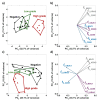Piercing the Shadows: Exploring the Influence of Signal Preprocessing on Interpreting Ultrasensitive Bioelectronic Sensor Data
- PMID: 39319362
- PMCID: PMC11826134
- DOI: 10.1002/cplu.202400520
Piercing the Shadows: Exploring the Influence of Signal Preprocessing on Interpreting Ultrasensitive Bioelectronic Sensor Data
Abstract
The development of ultrasensitive electronic sensors for in vitro diagnostics is essential for the reliable monitoring of asymptomatic individuals before illness proliferation or progression. These platforms are increasingly valued for their potential to enable timely diagnosis and swift prognosis of infectious or progressive diseases. Typically, the responses from these analytical tools are recorded as digital signals, with electronic data offering simpler processing compared to spectral and optical data. However, preprocessing electronic data from potentiometric biosensor arrays is still in its infancy compared to more established optical technologies. This study utilized the Single-Molecule with a Large Transistor (SiMoT) array, which has achieved a Technology Readiness Level of 5, to explore the impact of data preprocessing on electronic biosensor outcomes. A dataset consisting of plasma and cyst fluid samples from 37 patients with pancreatic precursor cyst lesions was analyzed. The findings revealed that standard signal preprocessing can produce misleading conclusions due to artifacts introduced by mathematical transformations. The study offers strategies to mitigate these effects, ensuring that data interpretation remains accurate and reflective of the underlying biochemical information in the samples.
Keywords: Chemometric data processing; Data preprocessing; Electrolyte gated field effect transistors; Pancreatic cancer early detection; Single molecule with a large transistor-SiMoT.
© 2024 The Author(s). ChemPlusChem published by Wiley-VCH GmbH.
Conflict of interest statement
The authors declare no conflict of interest.
Figures




References
-
- Macchia E., Torricelli F., Bollella P., Sarcina L., Tricase A., Di Franco C., Österbacka R., Kovács-Vajna Z. M., Scamarcio G., Torsi L., Chem. Rev. 2022, 122, 4636. - PubMed
-
- Macchia E., Torricelli F., Caputo M., Sarcina L., Scandurra C., Bollella P., Catacchio M., Piscitelli M., Di Franco C., Scamarcio G., Torsi L., Adv. Mater. 2024, 36, 2309705. - PubMed
-
- Torsi L., Magliulo M., Manoli K., Palazzo G., Chem. Soc. Rev. 2013, 42, 8612. - PubMed
MeSH terms
Grants and funding
- B93C22000840001/Centro di Innovazione Regionale Digital Assay
- GA:101040383/Centro di Innovazione Regionale Digital Assay
- 824946/Centro di Innovazione Regionale Digital Assay
- 2017RHX2E4/Centro di Innovazione Regionale Digital Assay
- PNC-E3-2022-23683266/Centro di Innovazione Regionale Digital Assay
- C43C22001630001/Centro di Innovazione Regionale Digital Assay
- PNC0000002/"Research initiatives for innovative technologies and pathways in the health and welfare sector"
- B53C22006420001/"Research initiatives for innovative technologies and pathways in the health and welfare sector"
- n.419161/Tecnologie portatili e protocolli innovativi per la diagnosi ultrasensibile di Xylella fastidiosa direttamente in piante e vettori (1LIVEXYLELLA)
- B93C22001920001/Research actions for reducing the impact on agricultural and natural ecosystems
- National Quantum Science and Technolgy Institute
- MUR-Dipartimenti di Eccellenza 2023-2027-Quantum Sensing and Modelling for One-Health (QuaSiModO)
LinkOut - more resources
Full Text Sources

